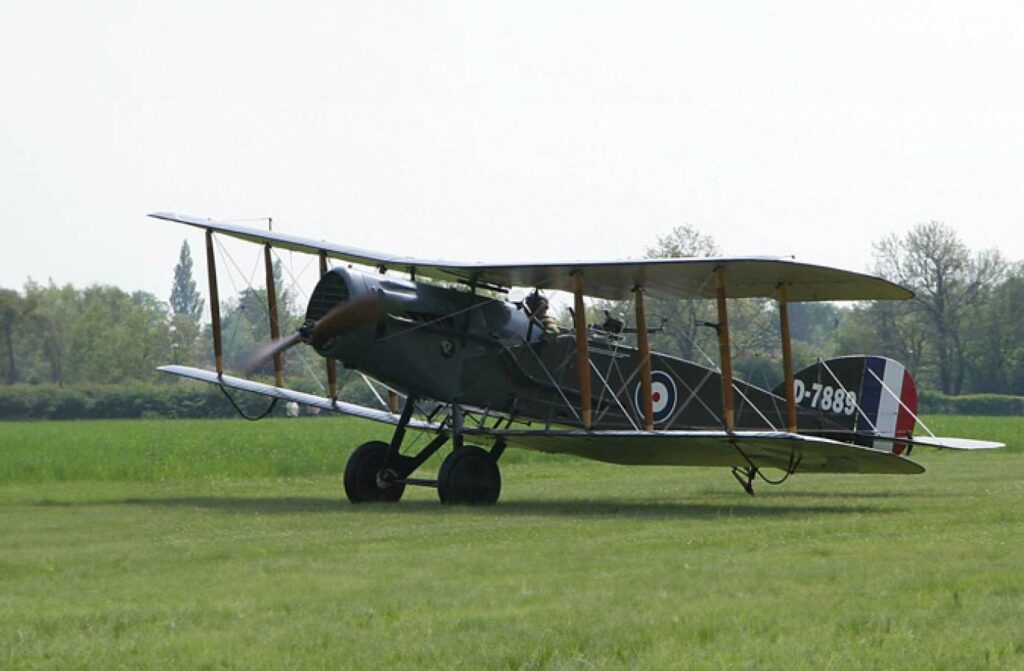A versatile British biplane, the Bristol F.2 Fighter, distinguished for its performance in WWI as a reconnaissance aircraft and fighter.
This article provides a comprehensive overview of the Bristol F.2 Fighter, covering its development, design, performance, and military use. It examines the aircraft’s historical context, innovative features, operational capabilities, and its notable role in World War I, illustrating its impact on aerial combat and military aviation. The Bristol F.2 Fighter, often simply referred to as the “Brisfit” or “Biff”, was a key British two-seater biplane of World War I. Renowned for its versatility and robustness, it significantly influenced air combat tactics and reconnaissance operations.
History of the Development of the Bristol F.2 Fighter
Historical Context:
In the midst of World War I, there was a pressing need for more effective reconnaissance aircraft that could also defend themselves against enemy fighters. The rapidly evolving air warfare demanded versatile and robust planes.
Development Objective:
The primary objective was to create a fast, agile, and sturdy aircraft that could perform both reconnaissance and combat roles effectively. The need for a dual-purpose aircraft was critical in the dynamic battlefields of WWI.
Program Launch:
The Bristol F.2 Fighter was developed by the British and Colonial Aeroplane Company, under the leadership of chief designer Frank Barnwell. The design and development were influenced by the need for a multi-role aircraft in the war.
First Flight:
The aircraft first took to the skies on September 9, 1916, demonstrating promising capabilities from its initial flights.
Design of the Bristol F.2 Fighter
Technical Specifications:
- Wingspan: 39 feet 3 inches (11.96 meters).
- Length: 25 feet 10 inches (7.87 meters).
- Height: 9 feet 6 inches (2.9 meters). Design Features:
The aircraft featured a conventional biplane structure with a single-engine. It had a distinctive negative stagger on the wings, which improved the pilot’s visibility and field of fire for the observer/gunner. Advantages:
The Bristol F.2 Fighter’s design allowed for excellent maneuverability and robustness, essential for dogfights and surviving in harsh battle conditions. Drawbacks:
Initially, its performance was not fully recognized, leading to a misconception that it was inferior in combat. Contributions:
The design philosophy of the Bristol F.2 Fighter influenced subsequent aircraft development, emphasizing versatility and robustness in military aircraft.

Performance of the Bristol F.2 Fighter
Engine and Power:
Equipped with a Rolls-Royce Falcon inline piston engine, it initially produced 190 horsepower (142 kilowatts), later increased in subsequent models.
Speed, Altitude, and Range:
- Maximum Speed: About 123 mph (198 km/h).
- Service Ceiling: 18,000 feet (5,486 meters).
- Range: Approximately 369 miles (594 kilometers). Comparative Analysis:
Compared to its contemporaries like the German Albatros D.III, the Bristol F.2 Fighter offered superior versatility, though it was slightly slower in speed.
Military Use and Combat of the Bristol F.2 Fighter
Armament:
It was typically armed with one forward-firing synchronized Vickers machine gun and one flexible Lewis gun for the observer.
Combat History:
The Bristol F.2 Fighter saw extensive use during WWI, especially on the Western Front. It was initially misunderstood tactically, leading to heavy losses, but later proved highly effective as a fighter and reconnaissance aircraft.
Competing Aircrafts and International Sales:
It competed with various German aircraft like the Albatros and Fokker series. Post-WWI, it saw sales to various countries and continued in service in limited roles.
Service Life:
After WWI, it continued to serve in various air forces until the late 1920s, eventually being phased out as newer aircraft designs emerged.
The Bristol F.2 Fighter stands as a testament to innovative aircraft design and versatility in military aviation. Its ability to adapt to the rapidly changing demands of WWI air combat and reconnaissance missions makes it a significant aircraft in the history of aerial warfare. Its legacy is evident in the principles it established for multi-role aircraft in military service.
Back to the Warbirds section.